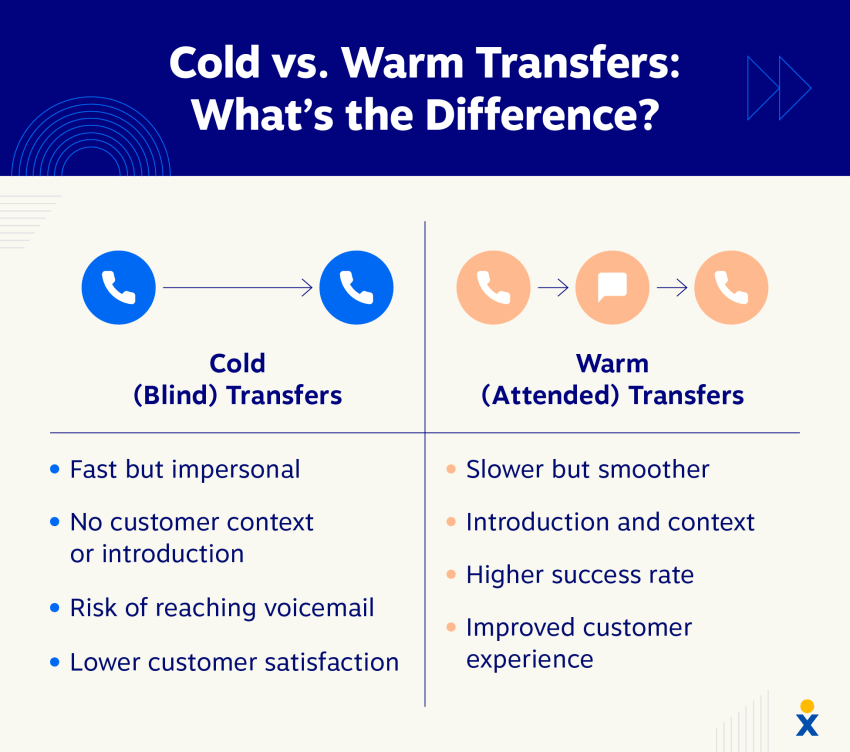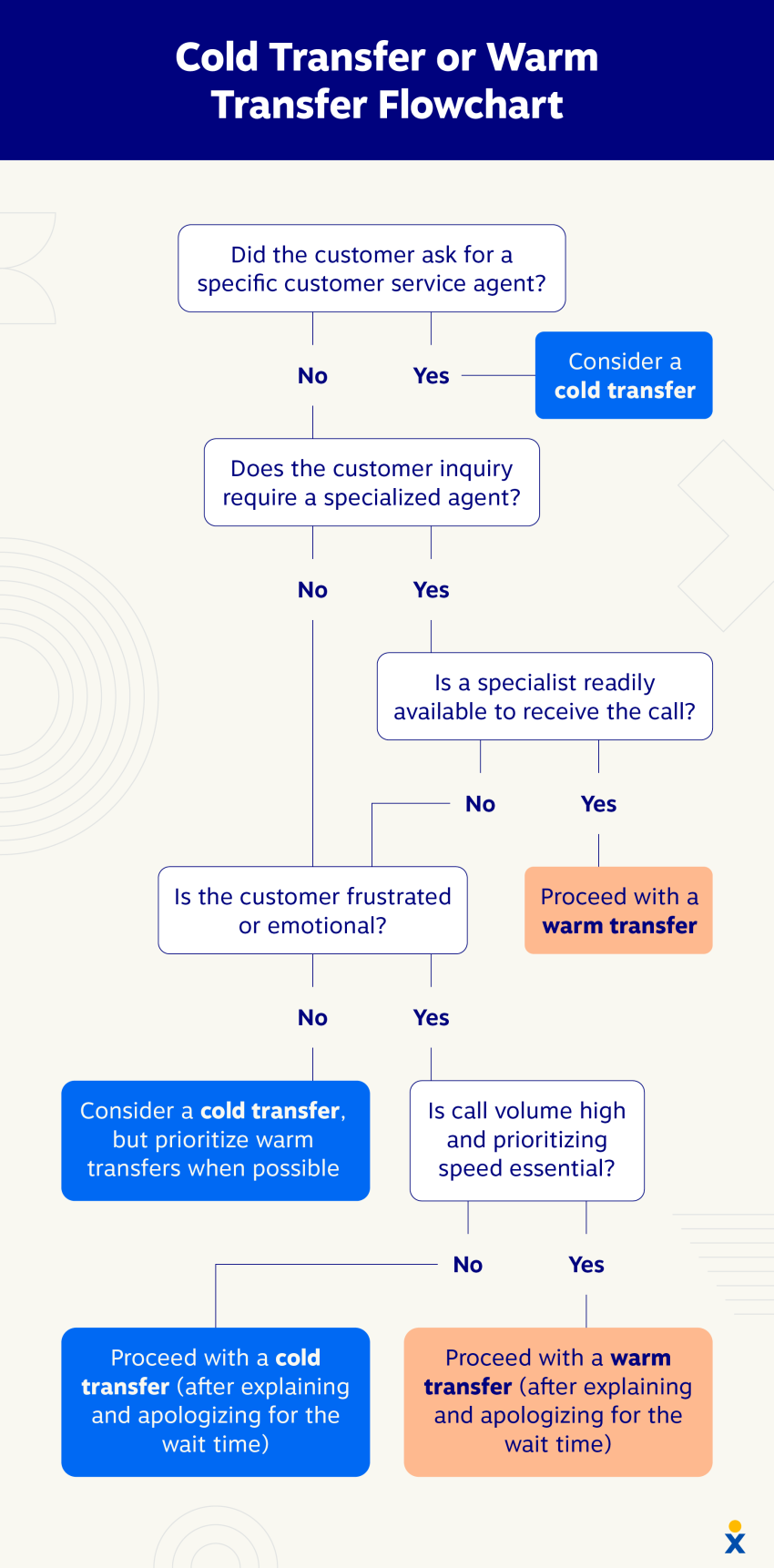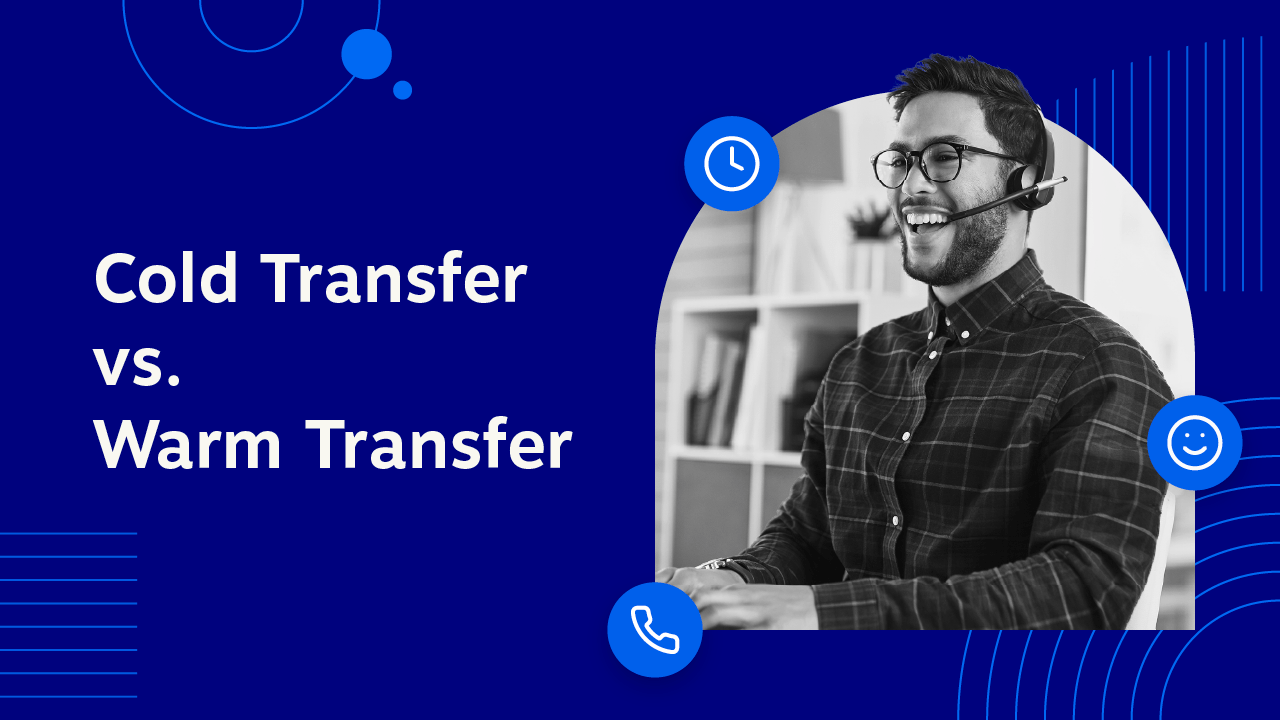| What’s the Difference Between a Warm Transfer and a Cold transfer? A warm transfer ensures a smooth call transfer between the initial agent and the receiving agent, complete with introductions and context, while a cold transfer is when the initial agent transfers the customer to another agent without warning. |
Customer experience 101: Don’t make customers repeat themselves.
Think about it: When you need customer support, do you want to explain your issue to an agent just to repeat the same story to someone else after being transferred? An exceptional customer experience (CX) is tied to every touchpoint across the customer journey. By simply warm-transferring a caller, you can add that little “extra” in an extraordinary customer experience.
Our guide breaks down the cold transfer vs. warm transfer processes in detail, including the examples, pros and cons, key differences, and which practice is more beneficial to customers and businesses alike.
What Is a Cold Transfer?
A cold transfer, also called a blind transfer, is when the initial agent connects the customer to another agent or department without communicating customer context or query details. The receiving agent has little or no information about the incoming call or what the customer needs. The customer must explain their issue or reason for reaching out again, leading to a frustrating customer experience.
| When to use it: It’s a best practice to use warm transfers whenever possible. However, you can use a cold transfer in these situations: – When a customer asks for a specific agent or department – When a customer reaches the wrong department that cannot assist with their issue – The call center receives a massive surge of calls – If you have an internal phone system, like a Private Branch Exchange (PBX) |
Cold transfer example
Here’s an example of a cold transfer exchange in action.
- Customer service agent: “Thank you for calling [Company Name]. My name is David. How can I help you today?”
- Customer: “Hi David, I’m having trouble logging in to my account. I keep getting an error message.”
- Customer service agent: “I understand, login issues can be frustrating. May I have your name and account number?
- Customer: “Jenny Smith. Account number 8675309.”
- Customer service agent: “Thank you, Jenny. It looks like several Platinum accounts are getting the same error messages. May I transfer you to our technical support team who can assist you further?”
- Customer: “Sure, thank you.”
- (Brief hold music)
- Technical support agent: “Technical support, this is Tommy. How may I assist you?”
- (Customer sighs)
- Customer: “Ugh, okay. Like I said, I keep getting an error message when I try logging into my account.”
- Technical support agent: “Gotcha. May I have your name and account number so I can take a look?”
This cold transfer interaction lacks positive and proactive elements that enhance the customer experience. Though the call center agent is polite, they use neutral language that doesn’t offer reassurance to the customer. The main issue is that the customer is transferred blindly to a new agent without providing an introduction or context, affecting CX and potentially harming your brand reputation.
Cold transfer pros and cons
Cold transfers can be useful for efficiency, but only use them strategically to avoid harming the customer experience. Consider warm transfers or alternative solutions whenever possible.
| Cold Transfer Pros | Cold Transfer Cons |
|---|---|
| Faster call resolution Improved agent efficiency Reduced costs | Negative customer experience Lack of context Lower customer satisfaction |
What Is a Warm Transfer?
A warm transfer refers to the process of an initial agent providing the relevant information and context of a customer interaction to a receiving agent before handing off the customer for further assistance. Warm transfers are preferred and should be part of your business’s call center strategy.
| When to use it: You should use a warm transfer whenever you want to deliver a positive customer experience. Some common situations to use a warm transfer include: – When a customer has a complex issue that requires an expert or specialized agent – When you need to escalate an issue or interaction – When an issue contains sensitive information or topics |
Warm transfer example
Now, let’s check out the same interaction from before, but as a warm transfer.
- Customer service agent: “Hi Jenny, thanks for calling [Company Name]. This is David. I see you’re having trouble logging in to your account. Don’t worry; these things happen sometimes! To get this resolved quickly, I’ll connect you directly with one of our technical support specialists who can troubleshoot the issue for you.”
- Customer: “Oh, that would be great! Thanks, David.”
- (Brief hold music)
- Customer service agent: “Great news, Jenny! I’ve connected you with a specialist named Tommy who’s familiar with this type of login issue. He already has your account information, so you can jump right into getting this resolved.”
- (Call transfers)
- Technical Support Agent: “Hi Jenny, this is Tommy from technical support. David provided your account info and filled me in on the login trouble you’re experiencing. Let’s take a look together and get you back into your account!”
- Customer: “Hi Tommy. Thank you!”
This warm transfer uses positive language like “don’t worry,” “quickly,” “directly,” and “jump right in” to reassure the customer. It also highlights the specialist’s knowledge and David’s proactive approach to solving the issue. This makes the experience smoother and less frustrating for Jenny.
Warm transfer pros and cons
The benefits of warm transfers can be significant for the customer experience and resolution speed, but they do sometimes increase your average handle time and resources. Here are a few pros and cons of taking a warm transferring approach.
| Warm Transfer Pros | Warm Transfer Cons |
|---|---|
| Enhanced customer experience Faster resolution Reduced agent errors | Increased handling time Agent availability Training requirements |
Key Differences Between Cold and Warm Transfers
The key differences between cold and warm transfers are in the level of communication and preparation involved before routing the customer to the receiving agent. Here’s a breakdown focusing on the communication dynamics, relationship building, and impact on CX:

1. Communication dynamics
A cold transfer involves minimal prior interaction, often leading to impersonal exchanges, while a warm transfer entails establishing rapport beforehand, fostering smoother transitions.
Think of a warm transfer like having a helpful friend at a party introducing you to everyone. The initial agent takes the time to establish some rapport, explain your situation to the receiving agent, and then smoothly connect you. This fosters a more welcoming and informative transition.
Imagine going to that same party, but your friend disappears into another room minutes after you arrive. That’s the vibe of a cold transfer. There’s minimal prior interaction between the first agent and the person you’re being transferred to. This often leads to impersonal exchanges where you have to repeat yourself and explain everything again.
2. Relationship building
A cold transfer lacks the opportunity for relationship development, whereas a warm transfer allows for trust-building and personalized assistance, enhancing customer engagement and satisfaction.

In warm transfers, when the initial agent introduces you by name and explains your situation, this adds a personal touch that puts all parties at ease.
Warm transfers:
- Help customers feel valued
- Demonstrate the brand’s genuine interest in resolving your problem
- Establishes trust and builds relationships
- Set the stage for a more positive and collaborative interaction with the specialist
A cold transfer doesn’t offer any opportunity for relationship development. They may leave customers feeling like a ticket number rather than a valued customer.
Blind transfers:
- Lack of personalization for your customers
- Offer missed opportunities to establish customer rapport
- Confuse and frustrate customers
In fact, a lot of cold transfers skip the human touch entirely. When callers interact with an auto-attendant or interactive voice response (IVR) system, their calls are typically automatically routed based on the option they select from a phone menu. IVRs are effective for fast support but may miss out on connecting with customers via human interactions.
3. Impact on customer experience
A cold transfer may result in frustration due to abrupt handoffs, whereas a warm transfer fosters a seamless experience, leading to higher customer loyalty and retention.
Abrupt handoffs without context can be frustrating. You may feel like you’re starting from scratch with each new agent. Cold transfers impact the customer experience by can lead to:
- Extended call times
- Loss of context
- Reduced confidence and loyalty
Warm transfers create a better customer experience. Even small businesses with limited support agents can use a VoIP phone system with an auto-attendant or virtual receptionist to help make warm transfers easier and more efficient. The specialist you connect with already has a basic understanding of your issue, allowing them to jump right in and start working on a solution.
Cold Transfer or Warm Transfer: Which Is Better for My Business?
Choosing between the different types of transfers hinges on the nature of your business calls and priorities.

Cold transferring a call is faster service but not necessarily good service. It can result in lower customer satisfaction and a risk of sending them to voicemail, especially for complex issues.
In contrast, a warm call transfer enhances customer satisfaction and efficiency by introducing the customer and providing context and background information to the receiving specialist. Still, they require slightly longer call handling time and depend on agent availability.
For best practices, train your agents on both transfer methods, invest in technology for seamless warm transfers, and monitor call center metrics and KPIs to gauge their impact on customer satisfaction and resolution rates. Aligning the right transfer method with your specific call types can optimize efficiency and create a more customer-centric experience.

Simplify Customer Call Handling with Nextiva
When we talk about warm transfer vs. cold transfer in customer service, the right software can help you put customer satisfaction front and center.
Nextiva’s contact center solution makes it easy to seamlessly transfer customers where they need to be. Its user-friendly features, like easy-to-navigate interfaces, phone tree, and call recording, make warm transfers a breeze.
And guess what? Nextiva’s omnichannel capabilities mean it’s not just about calls — it can handle all customer interactions smoothly, ensuring everyone remains happy.
The call center solution teams love.
Sales and support teams use Nextiva to deliver a better customer experience.
Cold Transfer vs. Warm Transfer FAQs
Check out these frequently asked questions about cold transfers vs. warm transfers.
Use a cold call transfer for simple inquiries or when your business has high call volumes. Use a warm transfer for complex issues, sensitive topics, or escalations.
Provide agents with a clear process for making call transfers more effective. Make call transfers more effective by briefly explaining the situation to the receiving agent and introducing the customer by name.
Warm transfers are generally preferred for customer satisfaction as they are more personal and efficient.
Warm and cold transfers can occur on any communication channel where a customer interacts with a support agent. These channels include phone calls, live chat, email, SMS, social media, and more.

















 Customer Experience
Customer Experience 










